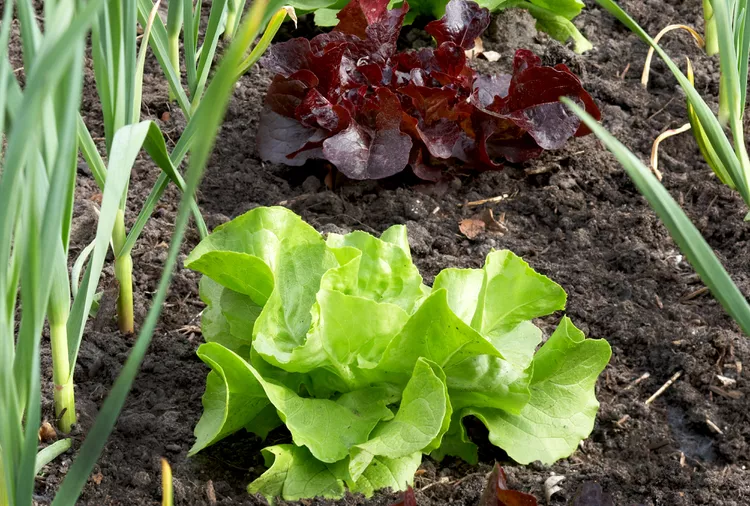10 Best Lettuce Companion Plants to Grow Together

The best lettuce companion plants tend to be vegetables, herbs, and flowers that thrive in cooler weather and appreciate regular watering. However, a top-notch companion plant should also benefit lettuce crops in some way. Many of the plants listed here help control garden pests naturally, but some also enhance lettuce's growth. You can grow these companion plants in large, in-ground gardens, but most also fit in small balcony gardens and pots. Keep your lettuce crop pest-free and growing strong by growing some of the companion plants in this list nearby to provide shade and keep bugs at bay.
Alliums
If you’ve ever struggled with pests on your lettuce plants but you don’t want to use pesticides in your garden, try growing alliums. Garlic, onions, chives, and other plants in the allium family have a strong and pungent odor that repels an assortment of garden pests. When used as lettuce companion plants, alliums can keep slugs, snails, deer, aphids, and other pests away and help you grow blemish-free lettuce leaves for salads and other recipes.
Root Vegetables
Root vegetables, such as carrots, beets, and radishes, don’t take up much space in garden beds, and their low growth habit means they won’t compete for sunlight when grown as lettuce companion plants. Since lettuce plants have shallow root systems, they don’t interfere with root vegetables in the soil, and you can pack a lot of plants into a small area by growing these plant types together. Best of all, root crops and lettuce grow well in spring and autumn gardens when many other vegetables are less productive.
Strawberries
It’s always an exciting time of the year when strawberry plants begin to fruit. However, pests can’t resist the bright red color and succulent taste of garden strawberries. One solution is to keep strawberries in hanging baskets, but you can also interplant lettuce near your strawberries to hide the berries from the watchful eyes of birds, rodents, and other garden visitors. Growing strawberries and lettuce together is also handy because these two plants have similar growing needs and thrive in cooler weather.
Cucumbers
Cucumbers and lettuce crave rich soil and plenty of water, so adding cucumbers as lettuce companion plants in a garden bed can streamline your gardening chores. Growing lettuce in the shade of vining cucumbers shields its leaves from bright sun and keeps lettuce from bolting early in summer. Growing lettuce beneath cucumber vines is also a good way to put empty soil to use and fit more plants in your garden.
Tomatoes
Tomatoes are relatively tall plants, and they can take up a lot of space in gardens and growing containers, but compact lettuce plants can easily grow around the base of tomatoes to maximize your garden space and help you produce a larger crop of vegetables. As with vining cucumbers, lettuce plants benefit from the added shade and are slower to bolt when temperatures rise in summer.
Beans and Peas
As with tomatoes and cucumbers, vining bean and pea plants can provide extra shade for lettuce and keep lettuce plants from bolting. Beyond that, beans and peas fix nitrogen in the soil, boosting the growth and health of nearby plants. Growing lettuce near legumes helps the lettuce plants produce more leaves and reduces the amount of fertilizer you need to apply to the lettuce crop.
Calendula
Calendula is mainly grown as a medicinal herb, but these plants can also be used in flower gardens or for bouquet making. Aside from their ornamental appeal, calendula is helpful for natural pest control, and these plants function as trap crops for slugs and snails. When integrated as lettuce companion plants, calendulas lure slugs away from lettuce and keep lettuce leaves pest-free and hole-free.
Spinach
Spinach and lettuce have similar growing requirements and don’t take up much space. Whether you have an in-ground garden or keep a few vegetables in pots, you can find space for lettuce and spinach. These two plants grow beautifully together and thrive in cool weather and rich soil.
Sweet Alyssum
Sweet alyssum is often planted in ornamental borders and container gardens but can also thrive in vegetable beds. These low-growing, flowering plants are well-known for attracting beneficial insects and pollinators to garden spaces. When grown as lettuce companion plants, sweet alyssum can draw in hoverflies, parasitic wasps, and other predatory insects that keep your lettuce plants and other vegetables naturally pest-free.
Asparagus
Asparagus spears are harvested toward the end of spring, but the feathery leaves of asparagus plants are typically left in place during the summer and fall to allow the plant to continue to photosynthesize. Saving space in your garden for asparagus leaves can reduce the available growing space in your beds. However, you can always fit a few lettuce companion plants beneath the asparagus leaves to get more fresh produce out of your garden. Interplanting lettuce beneath asparagus leaves keeps your garden beds productive throughout the seasons, and the lettuce will benefit from the added shade.
Fast-growing and compact, lettuce is an easy vegetable to grow. A loose leaf lettuce that grows well is 'Bauer', which grows high off the ground, so it stays cleaner. For head lettuce, compact 'Sunland' is a heat-tolerant variety that's compact and great for salads that call for hearts of romaine. Mini lettuces are great on a grill for summer recipes. 'Kolibri' is a bibb lettuce that grows in dryer soil, so it's a good choice for more arid locations.